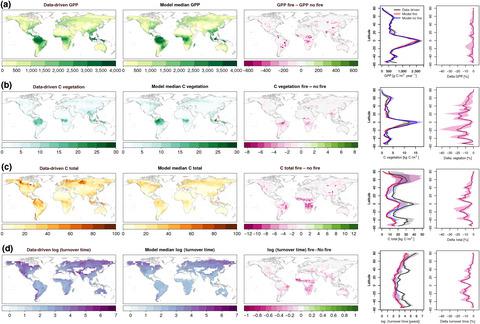当前位置:
X-MOL 学术
›
Glob. Change Biol.
›
论文详情
Our official English website, www.x-mol.net, welcomes your
feedback! (Note: you will need to create a separate account there.)
Global ecosystems and fire: Multi-model assessment of fire-induced tree-cover and carbon storage reduction.
Global Change Biology ( IF 10.8 ) Pub Date : 2020-05-14 , DOI: 10.1111/gcb.15160 Gitta Lasslop 1 , Stijn Hantson 2 , Sandy P Harrison 3 , Dominique Bachelet 4 , Chantelle Burton 5 , Matthias Forkel 6 , Matthew Forrest 1 , Fang Li 7 , Joe R Melton 8 , Chao Yue 9 , Sally Archibald 10 , Simon Scheiter 1 , Almut Arneth 11 , Thomas Hickler 1, 12 , Stephen Sitch 13
Global Change Biology ( IF 10.8 ) Pub Date : 2020-05-14 , DOI: 10.1111/gcb.15160 Gitta Lasslop 1 , Stijn Hantson 2 , Sandy P Harrison 3 , Dominique Bachelet 4 , Chantelle Burton 5 , Matthias Forkel 6 , Matthew Forrest 1 , Fang Li 7 , Joe R Melton 8 , Chao Yue 9 , Sally Archibald 10 , Simon Scheiter 1 , Almut Arneth 11 , Thomas Hickler 1, 12 , Stephen Sitch 13
Affiliation

|
In this study, we use simulations from seven global vegetation models to provide the first multi‐model estimate of fire impacts on global tree cover and the carbon cycle under current climate and anthropogenic land use conditions, averaged for the years 2001–2012. Fire globally reduces the tree covered area and vegetation carbon storage by 10%. Regionally, the effects are much stronger, up to 20% for certain latitudinal bands, and 17% in savanna regions. Global fire effects on total carbon storage and carbon turnover times are lower with the effect on gross primary productivity (GPP) close to 0. We find the strongest impacts of fire in savanna regions. Climatic conditions in regions with the highest burned area differ from regions with highest absolute fire impact, which are characterized by higher precipitation. Our estimates of fire‐induced vegetation change are lower than previous studies. We attribute these differences to different definitions of vegetation change and effects of anthropogenic land use, which were not considered in previous studies and decreases the impact of fire on tree cover. Accounting for fires significantly improves the spatial patterns of simulated tree cover, which demonstrates the need to represent fire in dynamic vegetation models. Based upon comparisons between models and observations, process understanding and representation in models, we assess a higher confidence in the fire impact on tree cover and vegetation carbon compared to GPP, total carbon storage and turnover times. We have higher confidence in the spatial patterns compared to the global totals of the simulated fire impact. As we used an ensemble of state‐of‐the‐art fire models, including effects of land use and the ensemble median or mean compares better to observational datasets than any individual model, we consider the here presented results to be the current best estimate of global fire effects on ecosystems.
中文翻译:

全球生态系统和火灾:火灾引起的树木覆盖和减少碳储存的多模型评估。
在这项研究中,我们使用来自七个全球植被模型的模拟来提供火灾对全球树木覆盖和当前气候和人为土地使用条件下的碳循环的影响的第一个多模型估计,其平均时间为2001-2012年。全球大火将树木覆盖面积和植被碳储量减少了10%。在区域上,效果要强得多,某些纬度带高达20%,热带稀树草原带高达17%。全球火灾对总碳存储量和碳周转时间的影响较低,对总初级生产力(GPP)的影响接近于0。我们发现大草原地区火灾的影响最大。燃烧面积最高的地区的气候条件与绝对火势影响最大的地区不同,后者的特点是降水量更高。我们对火生植被变化的估计低于以前的研究。我们将这些差异归因于对植被变化和人为土地利用的影响的不同定义,而先前的研究并未考虑这些因素,从而减少了火灾对树木覆盖的影响。考虑到火灾,大大改善了模拟树木覆盖的空间格局,这表明需要在动态植被模型中表示火灾。基于模型和观测值之间的比较,过程的理解和模型中的表示,与GPP,总碳存储和周转时间相比,我们评估了火灾对树木覆盖和植被碳的影响的可信度更高。与模拟火灾影响的全球总数相比,我们对空间模式有更高的信心。
更新日期:2020-05-14
中文翻译:

全球生态系统和火灾:火灾引起的树木覆盖和减少碳储存的多模型评估。
在这项研究中,我们使用来自七个全球植被模型的模拟来提供火灾对全球树木覆盖和当前气候和人为土地使用条件下的碳循环的影响的第一个多模型估计,其平均时间为2001-2012年。全球大火将树木覆盖面积和植被碳储量减少了10%。在区域上,效果要强得多,某些纬度带高达20%,热带稀树草原带高达17%。全球火灾对总碳存储量和碳周转时间的影响较低,对总初级生产力(GPP)的影响接近于0。我们发现大草原地区火灾的影响最大。燃烧面积最高的地区的气候条件与绝对火势影响最大的地区不同,后者的特点是降水量更高。我们对火生植被变化的估计低于以前的研究。我们将这些差异归因于对植被变化和人为土地利用的影响的不同定义,而先前的研究并未考虑这些因素,从而减少了火灾对树木覆盖的影响。考虑到火灾,大大改善了模拟树木覆盖的空间格局,这表明需要在动态植被模型中表示火灾。基于模型和观测值之间的比较,过程的理解和模型中的表示,与GPP,总碳存储和周转时间相比,我们评估了火灾对树木覆盖和植被碳的影响的可信度更高。与模拟火灾影响的全球总数相比,我们对空间模式有更高的信心。











































 京公网安备 11010802027423号
京公网安备 11010802027423号